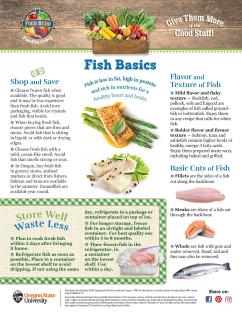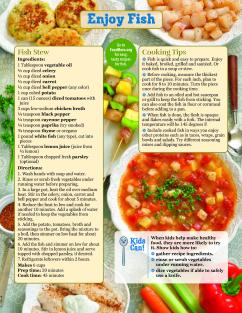Fish Basics
Fish is low in fat, high in protein and rich in nutrients for a healthy heart and brain.
Shop and Save
- Choose frozen fish when available. The quality is good and it may be less expensive than fresh fish. Avoid torn packaging, visible ice crystals and fish that bends.
- When buying fresh fish, choose pieces that are firm and moist. Avoid fish that is sitting in liquid, or with dark or drying edges.
- Choose fresh fish with a mild, ocean-like smell. Avoid fish that smells strong or sour.
- In Oregon, buy fresh fish in grocery stores, seafood markets or direct from fishers. Salmon and tuna are available in the summer. Groundfish are available year round.
Flavor and Texture of Fish
- Mild flavor and flaky texture — Rockfish, cod, pollock, sole and lingcod are examples of fish called groundfish or bottomfish. Enjoy them in any recipe that calls for white fish.
- Bolder flavor and firmer texture — Salmon, tuna and sablefish contain higher levels of healthy omega-3 fatty acids. Enjoy them prepared many ways, including baked and grilled.
Basic Cuts of Fish
- Fillets are the sides of a fish cut along the backbone.
- Steaks are the slices of a fish cut through the backbone.
- Whole are fish with guts and scales removed. Head, tail and fins may also be removed.
Store Well Waste Less
- Plan to cook fresh fish within 2 days after bringing it home.
- Refrigerate fish as soon as possible. Place in a container on the lowest shelf to avoid dripping. If not using the same day, refrigerate in a package or container placed on top of ice.
- For longer storage, freeze fish in an airtight and labeled container. For best quality use within 3 to 8 months.
- Thaw frozen fish in the refrigerator, in a container on the lowest shelf. Use within a day.
Enjoy Fish
Go to FoodHero.org for easy, tasty recipes for fish, including Fish Stew.
Cooking Tips
- Fish is quick and easy to prepare. Enjoy it baked, broiled, grilled and sautéed. Or cook fish in a soup or stew.
- Before cooking, measure the thickest part of the piece. For each inch, plan to cook for 8 to 10 minutes. Turn the piece once during the cooking time.
- Add fish to an oiled and hot saucepan or grill to keep the fish from sticking. You can also coat the fish in flour or cornmeal before adding to a pan.
- When fish is done, the flesh is opaque and flakes easily with a fork. The internal temperature will be 145 degrees F.
- Include cooked fish in ways you enjoy other proteins such as in tacos, wraps, grain bowls and salads. Try different seasoning mixes and dipping sauces.
Kids Can!
When kids help make healthy food, they are more likely to try it. Show kids how to:
- gather recipe ingredients.
- rinse or scrub vegetables under running water.
- dice vegetables if able to safely use a knife.




